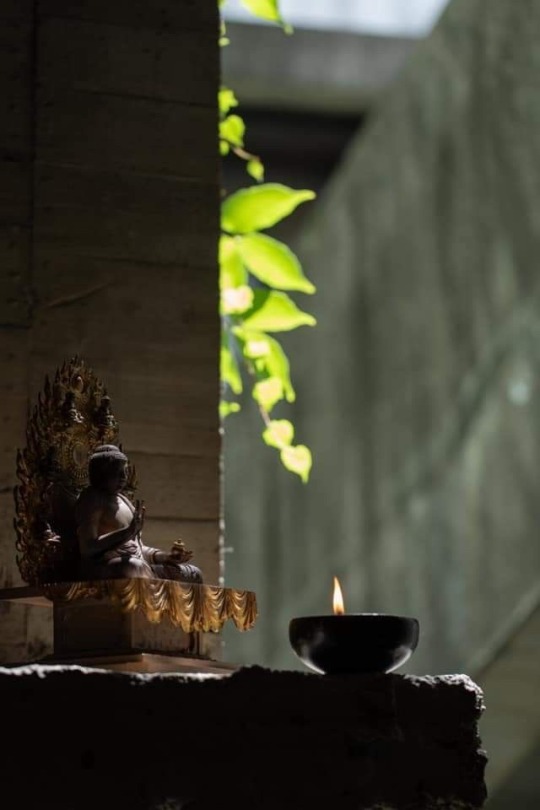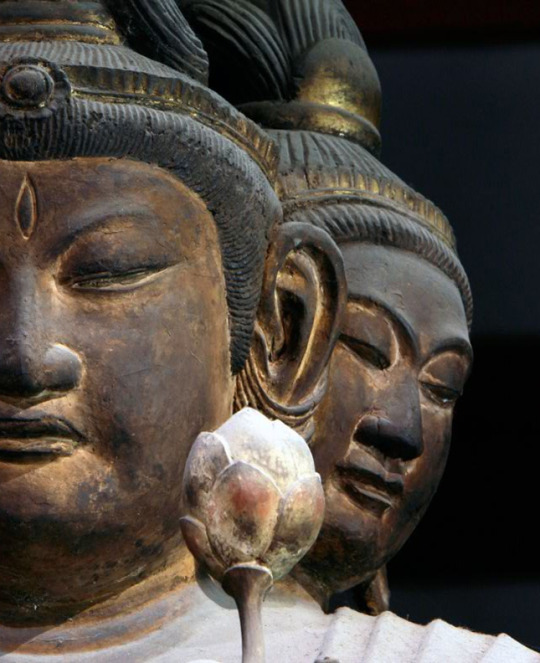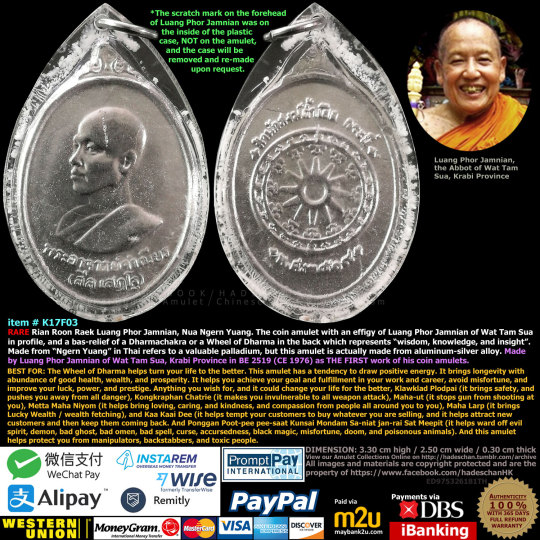#metta sutta
Text

From Amy/See the very interesting and beautifully written article below regarding the connection between Buddhism and St. Patrick.
[Red Pine (translator) :: Bill Porter (author)]
* * * * * *
In Christian lore, Patrick became the deer when he first returned to Ireland. After lighting the paschal fire in defiance of the tribal chieftain, he sang his protection song, often called "The Deer's Cry," and became a deer, binding himself to all the powers of creation and culminating in Christ:
Christ with me, Christ before me,
Christ behind me, Christ within me,
Christ beneath me, Christ above me,
Christ at my right, Christ at my left,
Christ in the fort, Christ in the chariot-seat, Christ in the mighty stern.
The Buddha's great protection song, the Metta Sutta, has the same encircling power given in a similar context of spiritual conflict. A group of monks settled in a forest for a retreat and the spirits tried to drive them away. The Buddha's encouragement wasn't enough so he bestowed on them a paritta protection chant. They made relatives with the spirits, who accepted and even began to protect them.
Radiating kindness over the entire world:
Spreading upwards to the skies,
And downwards to the depths;
Outwards and unbounded,
Freed from hatred and ill-will.
Whether standing or walking, seated or lying down
Catholics might see the Buddha as an "anonymous Christian," someone perfected by God's grace though never having learned of Jesus. Buddhist might see Patrick as a Bodhisattva, one that defers entry into Nirvana to pray for the happiness of all living beings.
I'll leave that debate to the side, for in them both I see the Deer: the essence of the spiritual journey and its connection to land, radiating compassion above, below, and all around.
[Saint Patrick and the Buddha]
#St. Patrick#Saint Patricks Day#Saint Patrick and the Buddha#Red Pine#Bill Porter#Buddhist#religious art#Amy See#Metta Sutta#The dear's Cry#paritta#protection chant
25 notes
·
View notes
Text
This is what should be done
By those who seek peace and harmony,
And who know the path of wisdom:
Let them be honest and sincere,
Respectful and humble in speech.
Kind and generous in action.
Content and grateful in attitude.
Mindful and aware in every moment.
Let them not be attached to views or opinions,
But open to dialogue and understanding.
Let them not be swayed by greed or hatred,
But guided by compassion and forgiveness.
Let them not be disturbed by praise or blame,
But grounded in equanimity and patience.
Let them cultivate a boundless heart
With regard to all beings:
Whether they are near or far,
Whether they are seen or unseen,
Whether they are born or unborn,
Whether they are human or non-human.
Let them wish for all beings to be happy and well,
To be free from suffering and its causes,
To be filled with joy and peace,
To be endowed with wisdom and virtue.
Let them radiate this loving-kindness
In all directions, without any limit,
Without any expectation, without any fear.
As a mother would protect her child
With her life, her only child,
Even so, let them cherish all beings
With a love that is unconditional and pure.
This is the way to live in harmony
With oneself and with the world.
This is the way to develop the mind
And attain the highest happiness.
This is the way to follow me
And realize the essence of his teaching.
0 notes
Text
The Vow
The vows I make are a big part of my New Year's ritual every year. Here they are!
We’ve reviewed the Four Noble Truths and the Noble Eightfold Path, two core principles of Buddhism. From these two ideas there’s a whole universe of interpretations, additions, and expansions. Every time Buddhism is introduced to a new culture, it tends to adapt towards the specific pressures that exist at that time. Tibetan Buddhism is different from the Zen Buddhism of Japan, the Pure Land…
View On WordPress
0 notes
Video
youtube
May all beings be at ease, without exception.
Karaniya Metta Sutta: The Buddha's Words on Loving-kindness
Link to full translation by The Amaravati Sangha
0 notes
Text

“Radiate boundless love towards the entire world — above, below, and across — unhindered, without ill will, without enmity.”
— Buddha
(From the Metta Sutta)
33 notes
·
View notes
Text

Loving-Kindness
This is what should be done By one who is skilled in goodness, And who knows the path of peace:
Let them be able and upright, Straightforward and gentle in speech, Humble and not conceited, Contented and easily satisfied,
Unburdened with duties and frugal in their ways.
Peaceful and calm and wise and skillful, Not proud or demanding in nature.
Let them not do the slightest thing That the wise would later reprove.
Wishing: In gladness and in safety, May all beings be at ease.
Whatever living beings there may be;
Whether they are weak or strong, omitting none, The great or the mighty, medium, short or small, The seen and the unseen, Those living near and far away, Those born and to-be-born - May all beings be at ease!
Let none deceive another,
Or despise any being in any state.
Let none through anger or ill-will
Wish harm upon another.
Even as a mother protects with her life Her child, her only child, So with a boundless heart Should one cherish all living beings;
Radiating kindness over the entire world:
Spreading upwards to the skies, And downwards to the depths;
Outwards and unbounded,
Freed from hatred and ill-will.
Whether standing or walking, seated or lying down Free from drowsiness,
One should sustain this recollection.
This is said to be the sublime abiding.
By not holding to fixed views, The pure-hearted one, having clarity of vision, Being freed from all sense desires, Will not be born again into this world.
Metta Sutta
The Buddha
18 notes
·
View notes
Photo

The Quest for Buddhism (111)
Buddhist cosmology
Brahmaviharas - The heart of compassion [Part1]
The heart of compassion is the basis of Buddhism. “May all living beings be blessed (Bhava: Sabbhe-Sattar. Bhavantu)”.
In the Tevijja Sutta, "The Threefold Knowledge" in the Digha Nikaya (DN) or "Collection of the Long Discourses", a group of young Brahmins consulted Lord Buddha about the methods to seek fellowship/companionship/communion with Brahma. He replied that he personally knows the world of Brahma and the way to it, and explains the meditative method for reaching it by using an analogy of the resonance of the conch shell of the astamangala:
A monk suffuses the world in the four directions with a mind of benevolence, then above, and below, and all around – the whole world from all sides, completely, with a benevolent, all-embracing, great, boundless, peaceful and friendly mind … Just as a powerful conch-blower makes himself heard with no great effort in all four directions, so too is there no limit to the unfolding of this heart-liberating benevolence. This is a way to communion with Brahma.
The Buddha then said that the monk must follow this up with an equal suffusion of the entire world with mental projections of compassion, sympathetic joy, and equanimity (regarding all beings with an eye of equality).
In the two Metta Suttas of the Anguttara Nikaya (AN), the Buddha states that those who practice radiating the four immeasurables in this life and die "without losing it" are destined for rebirth in a heavenly realm in their next life. In addition, if such a person is a Buddhist disciple (Skt: śrāvaka, Pāli: sāvaka) and thus realises the three characteristics of the five aggregates, then after his heavenly life, this disciple will reach nirvana. Even if one is not a disciple, one will still attain the heavenly life, after which, however depending on what his past deeds may have been, one may be reborn in a hell realm, or as an animal or hungry ghost.

仏教の探求 (111)
仏教の宇宙論
四無量心 (しむりょうしん) 〜慈悲のこころ(その1)
慈悲のこころは仏教の基本である。「生きとし生けるものが幸せでありますように (巴: サッヘ��-サッター・バーヴァントゥ・スッキータッター)」というのが、その基本となる精神である。
長部 (ちょうぶ、巴: ディーガ・ニカーヤ/DN)の「三重の知識」、三明経 (さんみょうきょう、巴: テーヴィッジャ・スッタ)に、若いバラモンの一団が梵天 (ぼんてん, 巴: ブラフマー) との交わり・友交・交信を求める方法についてブッダに相談する場面がある。ブッダは、梵天の世界とそこへの道を自ら知っていると答え、そこに至る瞑想法を法螺貝の共鳴になぞらえて説明した。
僧侶は四方の世界を慈悲の心で満たし、次に上、下、そして周り、つまり四方から完全に、慈悲深く、すべてを包み込み、大きく、無限に、平和で友好的な心で全世界を満たす・・・ちょうど、強力な法螺吹きは四方で大きな努力なしに自分の声が聞こえるように、この心を解放する慈悲を展開するのに制限はないのである。これは梵天との交信への道である。
そして、ブッダは、僧侶はこれに続いて、慈悲、同情の喜び、平静 (すべての存在を平等な目で見る) の心の投影を全世界に等しく充満させなければならないと述べている。
増支部 (ぞうしぶ、巴: アングッタラ・ニカーヤ/AN) の二つの慈経(メッタ・スッタ)では、現世で四無量心 (しむりょうしん、梵: アプラマーニャ, 巴: アッパマナー) を放ち、「失わずに」死んだ者は、来世で天界 (梵天界:ブラフマー・ロカ) に生まれ変わるように定められていると述べている。また、そのような人が声聞 (しょうもん、梵:シュラーヴァカ、巴: サーヴァカ、仏弟子のこと) であり、それによって五大要素の三つの特性を実現すれば、その仏弟子は天上界の後に涅槃に達することになる。弟子でなくても天寿を全うし、その後、過去の行いによって地獄に生まれ変わるか、動物や餓鬼に生まれ変わるかである。
#heart of compassion#buddha#buddhism#brahmaviharas#philosophy#nature#buddhist cosmology#the basis of buddhism#meditation#karma#reincarnation#brahma
120 notes
·
View notes
Quote
In gladness and in safety,
May all beings be at ease.
Whatever living beings there may be;
Whether they are weak or strong, omitting none,
The great or the mighty, medium, short or small,
The seen and the unseen,
Those living near and far away,
Those born and to-be-born —
May all beings be at ease!
Karaniya Metta Sutta: The Buddha's Words on Loving-kindness
22 notes
·
View notes
Text

Happy Valentine’s Day! Let your love grow! www.compassmethods.com
“Whatever living beings there may be;
Whether they are weak or strong, omitting none,
The great or the mighty, medium, short or small,
The seen and the unseen,
Those living near and far away,
Those born and to-be-born —
May all beings be at ease!” -Buddha, Karaniya Metta Sutta
https://youtube.com/@CompassionsCompass-sb7jo?si=jE9rP6bNMkKMcxqm
#compassion#mindfulness#mind#meditation#compassionate insight#compassmethods.com#wisdom#kindness#love#mindful education
3 notes
·
View notes
Text
5 notes
·
View notes
Text

“Radiate boundless love towards the entire world — above, below, and across — unhindered, without ill will, without enmity.”
– The Buddha
(From the Metta Sutta)
…🌱☀️
6 notes
·
View notes
Text
Metta Sutta: The Buddha's Words On Loving Kindness
Metta Sutta: The Buddha's Words On Loving Kindness:
This is what should be done
By one who is skilled in goodness
And who knows the path of peace
Let them be able and upright,
Straightforward and gentle in speech,
Humble and not conceited,
Contented and easily satisfied,
Unburdened with duties and frugal in their ways.
Peaceful and calm and wise and skillful,
Not proud or demanding in nature.
Let them not do the slightest thing
That the wise would later reprove.
Wishing: In gladness and in safety,
May all beings be at ease.
Whatever living beings there may be;
Whether they are weak or strong, omitting none,
The great or the mighty, medium, short or small,
The seen and the unseen,
Those living near and far away,
Those born and to-be-born —
May all beings be at ease!
Let none deceive another,
Or despise any being in any state.
Let none through anger or ill-will
Wish harm upon another.
Even as a mother protects with her life
Her child, her only child,
So with a boundless heart
Should one cherish all living beings;
Radiating kindness over the entire world:
Spreading upwards to the skies,
And downwards to the depths;
Outwards and unbounded,
Freed from hatred and ill-will.
Whether standing or walking, seated or lying down
Free from drowsiness,
One should sustain this recollection.
This is said to be the sublime abiding.
By not holding to fixed views,
The pure-hearted one, having clarity of vision,
Being freed from all sense desires,
Is not born again into this world.----Gautama Buddha
3 notes
·
View notes
Photo

We’re sorry, this item has sold out
item # K17F03
RARE Rian Roon Raek Luang Phor Jamnian, Nua Ngern Yuang. The coin amulet with an effigy of Luang Phor Jamnian of Wat Tam Sua in profile, and a bas-relief of a Dharmachakra or a Wheel of Dharma in the back which represents “wisdom, knowledge, and insight”. Made from “Ngern Yuang” in Thai refers to a valuable palladium, but this amulet is actually made from aluminum-silver alloy. Made by Luang Phor Jamnian of Wat Tam Sua, Krabi Province in BE 2519 (CE 1976) as THE FIRST work of his coin amulets.
……………………………………
BEST FOR: The Wheel of Dharma helps turn your life to the better. This amulet has a tendency to draw positive energy. It brings longevity with abundance of good health, wealth, and prosperity. It helps you achieve your goal and fulfillment in your work and career, avoid misfortune, and improve your luck, power, and prestige. Anything you wish for, and it could change your life for the better, Klawklad Plodpai (it brings safety, and pushes you away from all danger), Kongkraphan Chatrie (it makes you invulnerable to all weapon attack), Maha-ut (it stops gun from shooting at you), Metta Maha Niyom (it helps bring loving, caring, and kindness, and compassion from people all around you to you), Maha Larp (it brings Lucky Wealth / wealth fetching), and Kaa Kaai Dee (it helps tempt your customers to buy whatever you are selling, and it helps attract new customers and then keep them coming back. And Ponggan Poot-pee pee-saat Kunsai Mondam Sa-niat jan-rai Sat Meepit (it helps ward off evil spirit, demon, bad ghost, bad omen, bad spell, curse, accursedness, black magic, misfortune, doom, and poisonous animals). And this amulet helps protect you from manipulators, backstabbers, and toxic people.
……………………………………
DHARMACHAKRA
In Buddhism, the Dharma Chakra is widely used to represent the Buddha's Dharma (Buddha's teaching and the universal moral order), Buddha himself and the walking of the path to enlightenment, since the time of Early Buddhism. The symbol is also sometimes connected to the Four Noble Truths, the Noble Eightfold Path and Dependent Origination. The pre-Buddhist dharmachakra is considered one of the ashtamangala (auspicious signs).
The Buddha is said to have set the "wheel of dharma" in motion when he delivered his first sermon which is described in the Dhammacakkappavattana Sutta. This "turning of the wheel" signifies a great and revolutionary change with universal consequences, brought about by an exceptional human being. Buddhism adopted the wheel as a symbol from the Indic mythical idea of the ideal king, called a chakravartin ("wheel-turner", or "universal monarch"), who was said to possess several mythical objects, including the ratana cakka (the ideal wheel). The Mahā Sudassana Sutta of the Digha Nikaya describes this wheel as having a nave (nābhi), a thousand spokes (sahassārāni) and a felly (nemi), all of which are perfect in every respect. Siddhartha Gautama was said to have been a "mahapurisa" (great man) who could have chosen to become a wheel turning king, but instead became the spiritual counterpart to such a king, a wheel turning sage.
In his explanation of the term "turning the wheel of Dharma", the Theravada exegete Buddhaghosa explains that this "wheel" which the Buddha turned is primarily to be understood as wisdom, knowledge, and insight. This wisdom has two aspects, paṭivedha-ñāṇa, the wisdom of self-realization of the Truth and desanā-ñāṇa, the wisdom of proclamation of the Truth. The dharmachakra symbol also points to the central South Asian idea of "Dharma", a complex and multivalent term which refers to the eternal cosmic law, universal moral order and in Buddhism, the very teaching and path expounded by the Buddha.
In Buddhism, the cyclical movement of a wheel is also used to symbolize the cyclical nature of life in the world (also referred to as the "wheel of samsara", samsara-chakra or the "wheel of becoming", bhava-cakra). This wheel of suffering can be reversed or "turned" through the practice of the Buddhist path. The Buddhist terms for "suffering" (dukkha) and happiness (sukha) may also originally be related to the proper or improper fitting of wheels on a chariot's axle. The Indo-Tibetan tradition has developed elaborate depictions called Bhavacakras which depict the many realms of rebirth in Buddhist cosmology.
The spokes of a wheel are also often used as symbols of the Buddhist doctrine of dependent origination. According to the Theravada scholar Buddhaghosa:
“It is the beginningless round of rebirths that is called the ’Wheel of the round of rebirths’ (saṃsāracakka). Ignorance (avijjā) is its hub (or nave) because it is its root. Ageing-and-death (jarā-maraṇa) is its rim (or felly) because it terminates it. The remaining ten links [of Dependent Origination] are its spokes [i.e. saṅkhāra up to the process of becoming, bhava].”
……………………………………
DIMENSION: 3.30 cm high / 2.50 cm wide / 0.30 cm thick
……………………………………
item # K17F03
Price: price upon request, pls PM and/or email us [email protected]
100% GENUINE WITH 365 DAYS FULL REFUND WARRANTY
Item location: Hong Kong, SAR
Ships to: Worldwide
Delivery: Estimated 7 days handling time after receipt of cleared payment. Please allow additional time if international delivery is subject to customs processing.
Shipping: FREE Thailandpost International registered mail. International items may be subject to customs processing and additional charges.
Payments: PayPal / Western Union / MoneyGram /maybank2u.com / DBS iBanking / Wechat Pay / Alipay / INSTAREM / PromptPay International / Remitly
********************************************
1 note
·
View note
Text
This is what should be done
By one who is skilled in goodness,
And who knows the path of peace:
Let them be able and upright,
Straightforward and gentle in speech.
Humble and not conceited,
Contented and easily satisfied.
Unburdened with duties and frugal in their ways.
Peaceful and calm, and wise and skillful,
Not proud and demanding in nature.
Let them not do the slightest thing
That the wise would later reprove.
- The Buddha's Words on Kindness (Metta Sutta)
1 note
·
View note
Video
youtube
“My love to the Lordly cobras and to the pythons my love too, My love to vipers, adders and to the black Gotamas. My love to those with no feet, to those with two feet my love too. My love to those with four feet, to those with many feet my love too. Let the footless harm me not, nor the two-footed do me harm. Let the four-footed harm me not, nor the many-footed do me harm. All creatures and all breathing things, all beings none excepted, Good fortune may they see, and may no harm come near.”
Aṅguttara Nikāya 4:68 - Khandha Paritta
Paritta in Pali / Paritrana in Sanskrit, mean principally protection. Paritta suttas describe certain suttas or discourses delivered by the Buddha and regarded as affording protection. This protection is to be obtained by reciting or listening to the paritta suttas. The practice of reciting or listening to the paritta suttas began very early in the history of Buddhism. The word paritta, in this context, was used by the Buddha, for the first time, in a discourse known as Khandha Paritta in the Culla Vagga of the Vinaya Pitaka (vol. ii, p. 109), and also in the Anguttara Nikaya under the title "Ahi (metta) Sutta" (vol. ii, p. 82). This discourse was recommended by the Buddha as guard or protection for the use of the members of the Order. The Buddha in this discourse exhorts the monks to cultivate metta or loving-kindness towards all beings.
0 notes
Text

Buddha's Words On
Loving Kindness
FROM KARANIYA METTA SUTTA
This is what should be done
By one who is skilled in goodness, And who knows the path of peace:
Let them be able and upright,
Straightforward and gentle in speech.
Humble and not conceited,
Contented and easily satisfied,
Unburdened with duties and frugal in their ways.
Peaceful and calm and wise and skillful, Not proud or demanding in nature.
Let them not do the slightest thing
That the wise would later reprove.
Wishing: in gladness and in safety.
May all beings be at ease.
Whatever living beings there may be;
Whether they are weak or strong, omitting none, The great or the mighty, medium, short or small,
The seen and the unseen,
Those living near and far away.
Those born and to-be-born -
May all beings be at ease!
Let none deceive another,
Or despise any being in any state.
Let none through anger or ill-will
Wish harm upon another.
Even as a mother protects with her life
Her child, her only child, So with a boundless heart
Should one cherish all living beings;
Radiating kindness over the entire world:
Spreading upwards to the skies, And downwards to the depths;
Outwards and unbounded,
Freed from hatred and ill-will.
Whether standing or walking, seated or lying down
Free from drowsiness,
One should sustain this recollection.
This is said to be the sublime abiding.
By not holding to fixed views,
The pure-hearted one, having clarity of vision.
Being freed from all sense desires,
Is not born again into this world.
***
51 notes
·
View notes